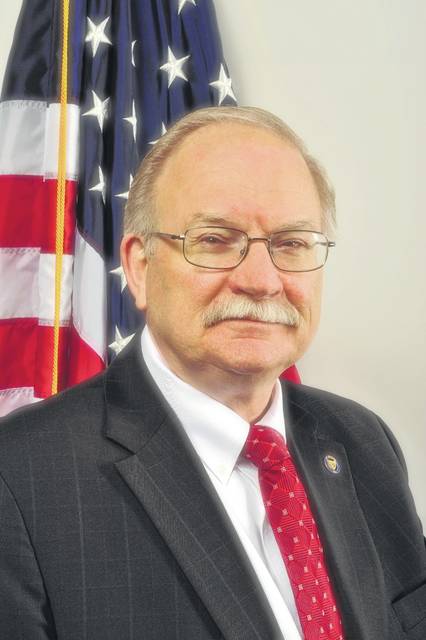
One of my former students recently returned from a lengthy trip, and was describing countries in Eastern Europe he had visited. “Bulgaria was perhaps the most interesting — beautiful scenery, beautiful people — and potholes the size of a football field.” When I asked if he had driven along Russell Road since he returned, he indicated that our potholes were “pinpricks in comparison.”
If that was supposed to make me feel better, it didn’t work. It seems like every day on my travels about Sidney, I find more potholes. And, we are not alone. When I visit neighboring communities like Piqua, Wapakoneta, Troy, Bellefontaine, Greenville and Urbana, I find that they too, have lots of potholes.
The winter was particularly hard on our roadways. We are much better served when the weather turns cold and stays cold. The cycles of thawing and freezing are particularly hard on roadways. Let me explain why.
A pothole is simply a structural failure in a road surface, usually asphalt pavement, due to water in the underlying soil structure and traffic passing over the affected area. As vehicles travel over the roadway, the pavement is designed to flex slightly under the pressure. Continued bending creates small cracks on the top and bottoms of the paved surface. When temperatures repeatedly fluctuate, as happened this year, water in these small cracks freezes, expands and then melts.
This spring the process repeated itself numerous times and eventually cracks from the top of the pavement surface connected to the bottom level cracks which allowed water to penetrate the soil beneath the pavement and begin to pool. This pooled water under the pavement then froze and expanded to form an ice dome between the soil and the bottom of the pavement. When this ice dome melts, and empty cavity remains … add the weight of a vehicle driving over this empty cavity and a pothole is born!
A complicating factor is the use of salt to clear roadways. Residents have grown accustomed to driving on clear streets, and road salt will melt snow and ice even when the temperature is below freezing. This allows water to seep into the cracks and crevices even if the ambient temperature is not above freezing. Even the snow-melt will freeze when the temperature drops, causing even greater problems.
Needless to say, the extreme temperature fluctuations this winter and early spring have wreaked additional havoc on our city streets. Our road crews have been out aggressively filling potholes. In the first four months of this year, city crews have filled 3,251 potholes at a cost of $61,751.26. In the entire 12 months of 2017, 3,902 potholes were filled. For comparison purposes, in 2014, a total of 6,333 potholes were filled at a price tag of $117,229.
This was, of course, prior to voters approving the additional 0.25 percent income tax levy for street maintenance and repair. Revenue generated from this additional tax is restricted solely for construction, reconstruction, resurfacing and maintenance of streets, alleys, curbs and gutters. Despite the nasty winter, the additional income tax dollars are making a difference in our city streets!
Collection of the additional income tax started in 2015 and the first street projects which included revenue from the levy were completed during the summer of 2015. It was not until 2016 that we received a full year of additional tax revenue collections, and street projects were awarded based on that full year of revenue collections.
In addition, the city appropriates, on average, an additional $600,000 from the General Fund to the Capital Improvement Fund for street resurfacing projects. Collection of the additional 0.25 percent tax continues through 2019.
In that first full year of additional tax collections (2015), $1,1586,234 was spent to address 4.84 miles of roadway. In 2016, $2,805,893 was spent to improve, maintain or repair 12.79 miles of roadway. Last year, 3,639,327 helped to treat 12.64 miles of roadway. This year, the city expected to spend over $3.9 million to address 13.96 miles of roadway!
It’s an interesting fact that from 2010-2014 (years prior to the tax levy) just 17.53 miles of roadway were paved or micro-surfaced. In the first three years of the additional funding, 27.32 miles of roadway were paved or micro-surfaced. Again, those additional income tax dollars are making a difference in trying to catch up maintaining city streets!
While we have made progress, we have a way to go before all 111 miles of city roadways will be in better condition than they were in 2014. We estimate approximately 47.61 miles of roadway have not been paved since 2010; this work has an estimated price tag of approximately $12 million. With projected revenues through 2022, the city expects to have roughly $5.5 million to complete about 22 miles of roadway.
That leaves 25.61 miles of roadway that will not see any type of improvement. In order to continue aggressively tackling the roadway issues in the community, the tax levy will need to be extended by voters. This is something City Council has been and will continue to discuss in depth in the coming months.
At the present time, using the average roadway lifespan of 12 years, the city estimates it will need approximately $2.5 million per year to keep our roadways maintained at an acceptable pavement condition rating. It will take continued support for the tax levy from the community to accomplish this goal.
In closing, should you have questions about the city’s resurfacing projects, please contact Assistant City Manager/Public Works Director Gary Clough by phone at 937-498-8141 or email to [email protected]. If you would like to report the location of a pothole, please contact Street Manager Brian Green by phone at 937-498-8159 or email to [email protected].


